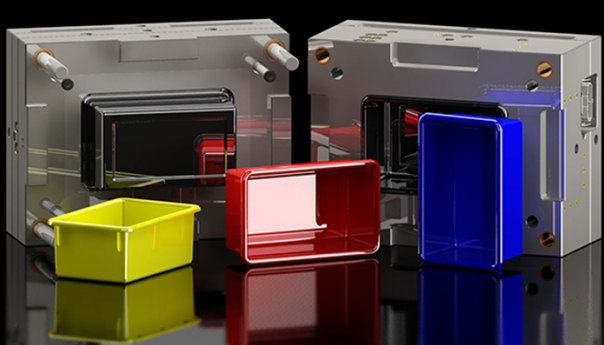Linee guida per la progettazione e la lavorazione di stampi a iniezione
1. The design and construction materials of the injection mold should select the appropriate mold steel according to the application requirements. If prototyping, you do not need to harden the die steel. In most cases, pre-hardened steel or aluminum is usually used to reduce costs and facilitate tool adjustment during the prototype stage. These soft metals can also cast sufficient test pieces and preforms. Pre-hardened tool steels (such as P-20 or make-55) are often used to make large tools because the hardening of tool steels is impractical in large-scale applications.
The injection mold design of the China plastic mold maker requires the use of hardened mold steel for the core and cavity. S-7, H-13, and stainless steel 420 are the most commonly used steels. S-7 is a diesel engine steel with excellent performance, which can be used for a long time in production and operation. If higher melt and mold temperatures are required, H-13 steel should be used. H-13 can also be used to make hot runner manifolds. tempered
H-13 is very hot and can withstand higher mold processing temperatures without compromising hardness.

Stainless steel is the best choice for tool steel if the application requires high wear resistance or the environment has a lot of condensates. Cavity inserts with high wear resistance can be made of A2, asp23, or D-2 steel.
All tool steels can rely on some kind of galvanic protection against wear and corrosion. Only stainless steel can be repaired by welding and machining. Coated steel can only be repaired after the coating has been removed. Repainting is required after maintenance.
2. Gates, runners, and gates for injection mold design
1. Gate Bushing
For traditional molds, the hot material enters the mold through the gate bushing. The runner system guides the material through the gate into the cavity. Correct design and correct size of gate bushings are critical for correct melt distribution and correct ejection of molded parts.
The gate “O” diameter should be approximately 20% larger than the nozzle exit diameter to prevent gate blockage during mold opening. The “O” dimension is also closely related to part and runner dimensions. Heated gate liners can be used in place of traditional gate liners. The initial cost of a heated gate (or “hot” bushing) may be higher than that of a “cold” bushing, but since it eliminates the gate connected to each part or runner system, it greatly reduces waste. Using a thermowell allows more precise control of the melt temperature entering the runner system.
2. runner design
The runners should be as short as possible to reduce unnecessary pressure drops. The cross-section is preferably circular. If the runner needs to be placed in the middle of the mold, use a trapezoidal round bottom runner.

Semicircular and flat runners are inefficient and not recommended. The runner should allow material to flow into one or more parts (if multiple cavities are used) in a balanced and unrestricted manner.
Typically, the diameter of the runner needs to be reduced by 20% for every 90 degrees of rotation. This should be taken into account when designing the runner system in the injection mold. The diameter of the circular runner is generally 0.125 to 0.375 (3.2 to 9.5mm).
3. Gate Design of Injection Mould Gate
LNP composite parts should provide sufficient machining space without in-mold stress. Some basic gate dimensions also control the fill rate, the amount of material flowing into the cavity, and the rate at which the part cures, depending on the type of gate used (i.e. delay, edge, lug, etc.). The wall thickness determines the size of the gate, and the part geometry determines the location of the gate on the part.
We are professional mold makers with more than ten years of experience. You won’t be disappointed by choosing us, Contattaci today.
Precedente:Comprerai i tuoi stampi e prodotti a iniezione in Cina
Prossimo: I professionisti ti presentano gli stampi a iniezione di plastica personalizzati
-
How are precision moulds made?
2024-12-3
In the vast field of manufacturing, precision moulds play a vital role. Not only are they key tools in the production of...
Visualizza dettagli -
Plastic Modern Chair Mould: Designing for a Contemporary Aesthetic
2023-6-22
The modern era has brought about a significant shift in the way we perceive design. In recent times, contemporary aesthe...
Visualizza dettagli -
Low Weight Plastic Injection Chair Mould
2023-6-18
Plastic injection molding is a widely used manufacturing process in the industry, and the demand for plastic products is...
Visualizza dettagli -
Injection Molding for Automotive Parts: An Efficient Manufacturing Solution
2023-5-26
Injection molding technology has been widely adopted in the automotive industry due to its efficiency in manufacturing h...
Visualizza dettagli -
Creating High-Quality Plastic Fruit Crate Molds: A Step Towards Sustainable Packaging Solutions
2023-8-16
Introduction: Plastic fruit crates have become an essential component of the agricultural industry, providing a convenie...
Visualizza dettagli -
Creazione di stampi in plastica di grandi dimensioni: una guida completa
2023-4-15
Creating large plastic molds requires a comprehensive approach to ensure the quality and accuracy of the final product. ...
Visualizza dettagli







